初中名词语法大全
英语语法初中基础知识大全

英语语法初中基础知识大全一、词法(一)名词1. 名词的分类普通名词:如book(书)、tree(树)、student(学生)等。
可分为可数名词和不可数名词。
专有名词:表示特定的人、地方、组织、机构等名称,如China(中国)、Tom(汤姆)、the Great Wall(长城)等。
首字母一般大写。
2. 名词的数可数名词有单数和复数形式。
规则变化:一般在词尾加s,如cat cats,dog dogs。
以s,x,ch,sh 结尾的名词,加es,如bus buses,box boxes,watch watches,brush brushes。
以辅音字母+ y 结尾的名词,把y 改i 再加es,如city cities,factory factories;但以元音字母+ y 结尾的名词,直接加s,如boy boys,day days。
以 f 或fe 结尾的名词,把 f 或fe 改为v 再加es,如knife knives,wife wives;但也有一些直接加s,如roof roofs。
不规则变化:如man men,woman women,child children,foot feet,tooth teeth 等。
不可数名词没有复数形式,如water(水)、milk(牛奶)、bread(面包)等。
计量时要用“数词+ 量词+ of + 不可数名词”的结构,如 a glass of water(一杯水),two pieces of bread(两片面包)。
3. 名词的所有格’s 所有格:一般在名词后加’s,如Mary’s book(玛丽的书)。
以s 结尾的复数名词,直接加’,如the students’ desks(学生们的课桌)。
表示两人或多人共有某物时,只在最后一个名词后加’s;若分别拥有,则每个名词后都加’s,如Tom and Jim’s room(汤姆和吉姆共有的房间);Tom’s and Jim’s rooms(汤姆的房间和吉姆的房间)。
初中英语名词大全汇总电子版免费(中学英语语法解析)

初中英语名词大全汇总电子版免费(中学英语语法解析)名词所有格名词所有格是指一个名词与另一个名词之间存在所有关系时所用的形式。
其构成有两种:一种是由名词末尾加’s构成;另一种由介词of加名词构成。
前者多用来表示有生命的东西;后者多用来表示无生命的东西。
例如:Children’s Palace 少年宫Tom’s bike 汤姆的自行车the title of the book 书名the legs of the table 桌子的腿(一)所有格形式的构成(1)单数名词后加’s,其读音与名词复数结尾的读音相同。
例如:the girl’s father 女孩的父亲(2)以s结尾的复数名词后加’。
例如:two hours’ walk 两个小时的步行(3)不以s结尾的复数名词后加’s。
例如:the children’s holiday 孩子们的节日(4)以s结尾的人名,可以加’s,也可加’号。
例如:Thomas’s brother 托马斯的兄弟(5)表示各自的所有关系,不是共有的,则要分别在名词末尾加’s 若一样东西为两人共有,则后一个人名用所有格;如果不是两人共有,而是各有各的,则两个名词都用所有格,且其后名词应为复数。
例如:John’s and Mary’s rooms 约翰和玛丽各人的房间若表示共有的,则在最后一个名词的末尾加’s,如:John and Mary’s room 约翰和玛丽合住的房间(二)’s所有格的用法’s所有格常表示有生命的东西,但也可表示无生命的东西。
例如:(1)表示时间:today’s newspaper 今天的报纸(2)表示自然现象:the moon’s rays 月光(3)表示国家、城市机构:Shanghai’s industry 上海的工业(4)表示度量衡及价值:twenty dollars’ value 20美元的价值five miles’ distance 5英里的距离(三)of 所有格用法凡不能加’s的名词,都可以与of构成短语,来表示所有关系。
初中英语名词语法
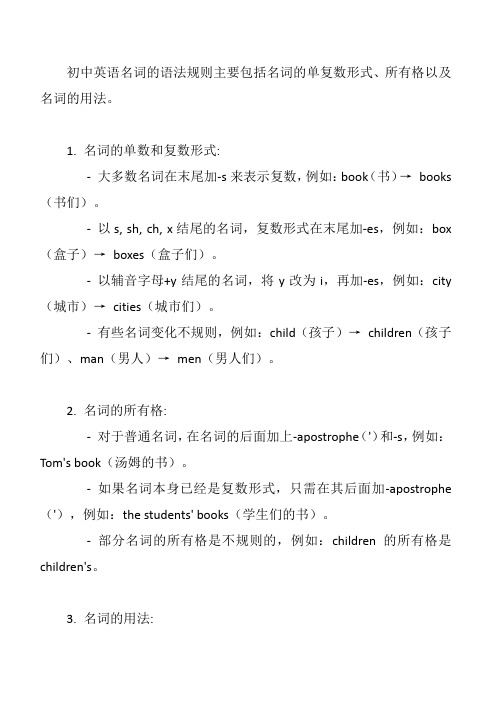
初中英语名词的语法规则主要包括名词的单复数形式、所有格以及名词的用法。
1. 名词的单数和复数形式:
-大多数名词在末尾加-s来表示复数,例如:book(书)→books (书们)。
-以s, sh, ch, x结尾的名词,复数形式在末尾加-es,例如:box (盒子)→boxes(盒子们)。
-以辅音字母+y结尾的名词,将y改为i,再加-es,例如:city (城市)→cities(城市们)。
-有些名词变化不规则,例如:child(孩子)→children(孩子们)、man(男人)→men(男人们)。
2. 名词的所有格:
-对于普通名词,在名词的后面加上-apostrophe(')和-s,例如:Tom's book(汤姆的书)。
-如果名词本身已经是复数形式,只需在其后面加-apostrophe ('),例如:the students' books(学生们的书)。
-部分名词的所有格是不规则的,例如:children 的所有格是children's。
3. 名词的用法:
-名词可作为主语、宾语或表语,例如:The cat is on the table (猫在桌子上)。
-名词可以修饰其他名词,形成名词短语,例如:a bookshelf(书架)。
-名词可以具有冠词(a/an/the)或其他限定词来修饰,例如:an apple(一个苹果)、the dog(那只狗)。
-名词还可以用作复合词的一部分,例如:birthday(生日)、classroom(教室)。
以上是初中英语名词的基本语法规则,希望对你有所帮助!。
初中英语语法大全(含练习)30页
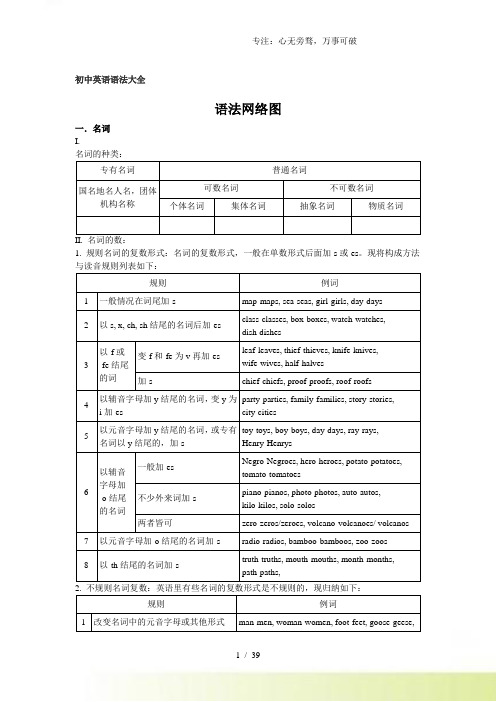
初中英语语法大全语法网络图一.名词I.专有名词普通名词国名地名人名,团体机构名称可数名词不可数名词个体名词集体名词抽象名词物质名词II. 名词的数:1. 规则名词的复数形式:名词的复数形式,一般在单数形式后面加-s或-es。
现将构成方法规则例词1一般情况在词尾加-s map-maps, sea-seas, girl-girls, day-days2以s, x, ch, sh结尾的名词后加-es class-classes, box-boxes, watch-watches, dish-dishes3以-f或-fe结尾的词变-f和-fe为v再加-esleaf-leaves, thief-thieves, knife-knives,wife-wives, half-halves加-s chief-chiefs, proof-proofs, roof-roofs4以辅音字母加y结尾的名词,变y为i加-esparty-parties, family-families, story-stories,city-cities5以元音字母加y结尾的名词,或专有名词以y结尾的,加-stoy-toys, boy-boys, day-days, ray-rays,Henry-Henrys6以辅音字母加-o结尾的名词一般加-esNegro-Negroes, hero-heroes, potato-potatoes,tomato-tomatoes不少外来词加-spiano-pianos, photo-photos, auto-autos,kilo-kilos, solo-solos两者皆可zero-zeros/zeroes, volcano-volcanoes/ volcanos7以元音字母加-o结尾的名词加-s radio-radios, bamboo-bamboos, zoo-zoos8以-th结尾的名词加-s truth-truths, mouth-mouths, month-months, path-paths,规则例词1改变名词中的元音字母或其他形式man-men, woman-women, foot-feet, goose-geese,mouse-mice2单复数相同sheep, deer, means, works, fish, yuan, jin, 3只有复数形式trousers, clothes, thanks, goods, glasses, 4一些集体名词总是用作复数people, police5部分集体名词既可以作单数(整体)也可以作复数(成员)class, family, crowd, couple, group, government,population, team, public, party6复数形式表示特别含义customs(海关), times(时代), spirits(情绪), drinks(饮料), sands(沙滩), papers(文件报纸), looks(外表), brains(头脑智力), greens(青菜)7表示“某国人”加-sAmericans, Australians, Germans, Greeks,Swedes, Europeans单复数同形Swiss, Portuguese, Chinese, Japanese以-man或-woman结尾的改为-men,-womenEnglishmen, Frenchwomen8合成名词将主体名词变为复数sons-in-law, lookers-on, passers-by, story-tellers,boy friends无主体名词时将最后一部分变为复数grown-ups, housewives, stopwatches 将两部分变为复数women singers, men servantsIII. 名词的所有格:名词在句中表示所有关系的语法形式叫做名词所有格。
初中语法大全

一、名词(含主谓一致)1、定义:表示人\事物\地点和抽象事物的词.2、分类:专有名词和普通名词(可数名词和不可数名词).3.、可数名词可以用数目来计算,不可数名词无法用数目来计算,无复数形式且不可用不定冠词a,an修饰.4 、名词在句子中可作主语、表语、补语、同位语、宾语(动宾、介宾)、定语、状语等.His name is Tom. We call him Tom. Tom is a student.My classmate,Tom is from America. We like Tom. in the treeOrange juice He got home full of anger.5、名词变复数a. 一般在单数名词后加”-s ”.但词尾为-s\-x\-ch\-sh结尾的名词,则需加‟‟-es‟‟来构成复数.b. 以-y结尾的名词,y前为辅音字母时,变y为i再加-es,y前为元音字母时,直接加-s.但Mary,Henry后加-s.zeroc. 以-f/fe结尾的,一般变为-ves,knife, half , self, leaf, wife, life, thief, wolf.但roof-roofs(屋顶,房顶),safe-safes(保险柜).d. 以-o结尾的名词,Negro, hero, potato, tomato, mango加-es. .zoo,radio,piano,photo,kilo,bamboo后加s. zero后加-s或-es均可。
e. 下列名词单复数相同:sheep,fish,deer,Chinese,Japanese, yuan,jin.f. 特殊变化:man, woman, foot ,child, mouse,tooth,German. ox等。
g. chicken,room, glass, orange, paper,experience, radio,fish, light等既可以做C,又可做U.6、名词所有格a. 定义:表示人或事物的隶属和拥有关系。
初中英语语法名词

many
much
few
little
a few
a little
some
some
plenty of
plenty of
A lot of/lots of A lot of/lots of
很多 很少 一些 一些 许多 许多
• 注意
• 1)People 是集体名词,但当民族讲时可以用复 数Peoples
• 2)以复数形式出现的书名,剧名报纸杂志名也是 为单数
2,000. 4. The woman with two children __i_s___( is ,are ) coming
here. 5. Neither he nor I __a_m__(are, am ) an American.
指点迷津
6. Maths ___is___(are, is ) hard to learn for the boy. 7. They are all __w_o_m_e_n_t_e_ac_h_e_rs___( woman, teachers ;
Shanghai.
1.Several _____ are talking under the tree.And they are__C____.
A.woman;children B.woman;child C.women;children
2.—How far is your school from here? —Not very far.It's about twenty C walk.
(2)以-s, -x, -sh, -ch结尾的加-es 读/iz/ 例如: box→boxes bus→buses watch→watches
初中英语语法大全:名词
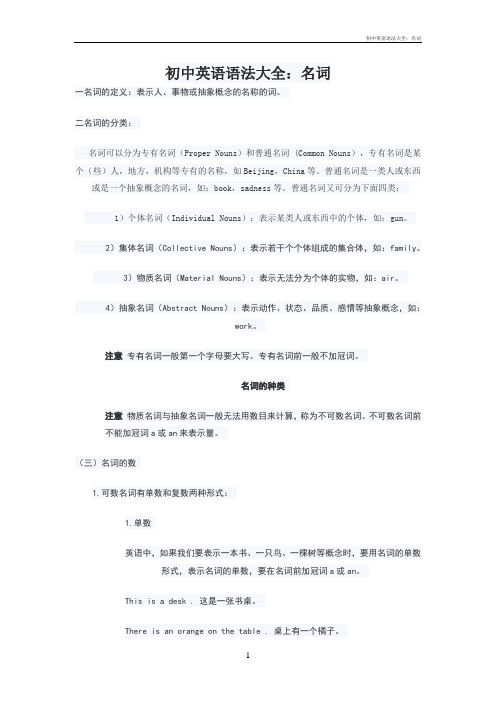
初中英语语法大全:名词一名词的定义:表示人、事物或抽象概念的名称的词。
二名词的分类:名词可以分为专有名词(Proper Nouns)和普通名词 (Common Nouns),专有名词是某个(些)人,地方,机构等专有的名称,如Beijing,China等。
普通名词是一类人或东西或是一个抽象概念的名词,如:book,sadness等。
普通名词又可分为下面四类:1)个体名词(Individual Nouns):表示某类人或东西中的个体,如:gun。
2)集体名词(Collective Nouns):表示若干个个体组成的集合体,如:family。
3)物质名词(Material Nouns):表示无法分为个体的实物,如:air。
4)抽象名词(Abstract Nouns):表示动作、状态、品质、感情等抽象概念,如:work。
注意专有名词一般第一个字母要大写。
专有名词前一般不加冠词。
名词的种类注意物质名词与抽象名词一般无法用数目来计算,称为不可数名词。
不可数名词前不能加冠词a或an来表示量。
(三)名词的数1.可数名词有单数和复数两种形式:1.单数英语中,如果我们要表示一本书、一只鸟、一棵树等概念时,要用名词的单数形式,表示名词的单数,要在名词前加冠词a或an。
This is a desk . 这是一张书桌。
There is an orange on the table . 桌上有一个橘子。
an orange 一个橘子 an new orange (×)→a new orange (○)一个新橘子a desk a old desk (×)→ an old desk (○)一张旧课桌a和an的使用区别a加在以辅音开头的名词前,如a book,a pen。
an加在以元音开头的名词前,如an egg,an apple。
注意有时a,an后面紧接的不是单数名词,而是a (an) +形容词+单数名词的形式。
初中英语语法大全(精华版)

初中英语语法大全(精华版)一、词法1. 名词名词是表示人、事物、地点或抽象概念的词。
名词有可数名词和不可数名词之分。
(1) 可数名词可数名词有单数和复数两种形式。
复数形式通常在单数形式后加上s或es。
(2) 不可数名词不可数名词没有复数形式,表示的是无法分割的整体或抽象概念。
2. 冠词冠词是放在名词前面的词,用来表示名词的特指或泛指。
(1) 不定冠词a/an不定冠词a用于辅音音素开头的单词前,an用于元音音素开头的单词前。
(2) 定冠词the定冠词the表示特指,即指说话人和听话人都知道的特定的人或事物。
3. 代词代词是用来代替名词的词,包括人称代词、物主代词、指示代词等。
(1) 人称代词人称代词有主格、宾格和所有格三种形式。
(2) 物主代词物主代词表示所有关系,分为形容词性物主代词和名词性物主代词。
(3) 指示代词指示代词用来指代前面提到的人或事物,有this/that/these/those等。
4. 形容词形容词是用来修饰名词的词,表示人或事物的性质、状态等。
5. 副词副词是用来修饰动词、形容词、其他副词或全句的词,表示时间、地点、程度等。
二、句法1. 句子成分句子成分包括主语、谓语、宾语、定语、状语等。
(1) 主语主语是句子叙述的对象,表示句子讲述的是“谁”或“什么”。
(2) 谓语谓语是句子中表示动作、状态或存在的部分,说明主语“做什么”、“是什么”或“怎么样”。
(3) 宾语宾语是句子中表示动作的对象,表示动作的承受者。
(4) 定语定语是句子中修饰名词的成分,表示名词的性质、特征等。
(5) 状语状语是句子中表示时间、地点、原因、条件、程度等的成分。
2. 基本句型英语句子有五种基本句型,分别是:(1) 主语+谓语(2) 主语+谓语+宾语(3) 主语+谓语+宾语+宾语(4) 主语+谓语+宾语+宾语补足语(5) 主语+系动词+表语3. 简单句、并列句和复合句(1) 简单句简单句是由一个主语和一个谓语构成的句子。
《初中语文语法大全》(共34张PPT)

句子 种类
结构 分
①动词谓语句:你改悔吧! ②形容词谓语句:我气量大.
单句
主谓句
③名词谓语句:每人一盏灯. ④主谓谓语句:我的讲义,你能抄
八下
下来吗?
21页
①动词非主谓句标志极了. 谓句 ③名词非主谓句:一盏灯!
①因果复句
因果类复句 ②假设复句
九上29页 ③条件复句
句子
句子:
1、概念:由短语或词构成,是具有特定句调,能够表达一 个相对完整的意思的语言单位.
2、标志:
〔1必须具有一个相对独立完整的意思.
〔2必须具有一定的语气和语调,在书面上有一个句末标点.
3.例如:
雷锋是我们时代的杰出代表〔短语
雷锋是我们时代的杰出代表!〔句子
同学们,你们懂不懂这个问题呀?
懂!
〔1北风呼呼叫,大雪纷纷飘. 〔2外面叭叭地响起枪声.
作句子 的成分.
〔3河水哗哗地流着.
〔4咣,门被什么人踢开了. 〔5轰隆隆!外面传来一声炮响.
作句子.
看谁判断有对又快: 连词 形容词
动词
量词
1.左拉有一副朴实但很固执的脸庞.
名词
名词 数词 形容词 副词
助词
副词
介词
2.月色便朦胧在这水汽里.
名词
四、助词;
1、概念:附着在词或短语后,表示某种语法意义.
2、种类:看前面可知有结构助词、情态助词、语气 助词.
3、语法功能:和别的词语共同构成句子成分.
〔1我们民族历史上最〔灿烂的〔科学的春天到来了. 〔2大家都[圆满地]完成了自己的任务. 〔3李老师高兴<得说不出话来>.
结构助词
看下面的例子:
语气助词
初中英语语法(名词)
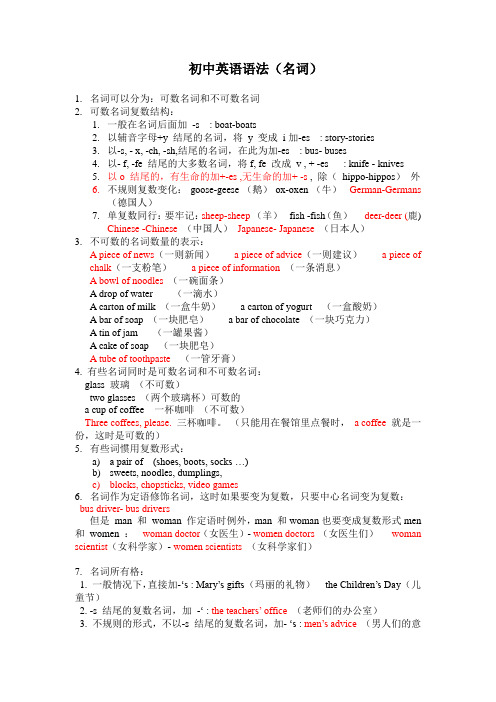
初中英语语法(名词)1.名词可以分为:可数名词和不可数名词2.可数名词复数结构:1.一般在名词后面加-s : boat-boats2.以辅音字母+y 结尾的名词,将y 变成i加-es : story-stories3.以-s, - x, -ch, -sh,结尾的名词,在此为加-es : bus- buses4.以- f, -fe 结尾的大多数名词,将f, fe 改成v , + -es : knife - knives5.以o 结尾的,有生命的加+-es ,无生命的加+ -s , 除(hippo-hippos)外6.不规则复数变化:goose-geese (鹅)ox-oxen (牛)German-Germans(德国人)7.单复数同行:要牢记:sheep-sheep(羊)fish -fish(鱼)deer-deer (鹿)Chinese -Chinese(中国人)Japanese- Japanese(日本人)3.不可数的名词数量的表示:A piece of news(一则新闻) a piece of advice(一则建议) a piece ofchalk(一支粉笔) a piece of information(一条消息)A bowl of noodles(一碗面条)A drop of water (一滴水)A carton of milk (一盒牛奶) a carton of yogurt (一盒酸奶)A bar of soap (一块肥皂) a bar of chocolate (一块巧克力)A tin of jam (一罐果酱)A cake of soap (一块肥皂)A tube of toothpaste (一管牙膏)4. 有些名词同时是可数名词和不可数名词:glass 玻璃(不可数)two glasses (两个玻璃杯)可数的a cup of coffee 一杯咖啡(不可数)Three coffees, please. 三杯咖啡。
(完整版)初中英语名词复数、语法大全
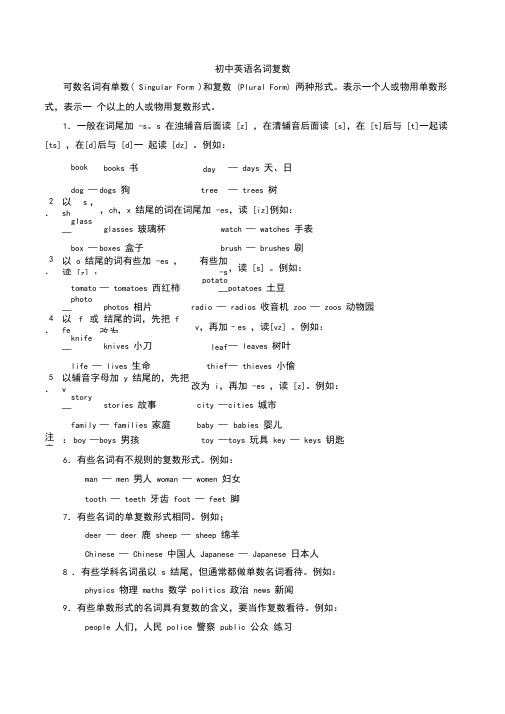
初中英语名词复数可数名词有单数( Singular Form )和复数(Plural Form) 两种形式。
表示一个人或物用单数形式,表示一个以上的人或物用复数形式。
1.一般在词尾加-s。
s 在浊辅音后面读[z] ,在清辅音后面读[s],在[t]后与[t]一起读[ts] ,在[d]后与[d]一起读[dz] 。
例如:book—books 书day —days 天、日dog —dogs 狗tree —trees 树2.以s,sh,ch,x 结尾的词在词尾加-es,读[iz]例如:glass—glasses 玻璃杯watch —watches 手表box —boxes 盒子brush —brushes 刷3.以o 结尾的词有些加-es ,读[z] ;有些加-s,读[s] 。
例如:tomato —tomatoes 西红柿potato—potatoes 土豆photo—photos 相片radio —radios 收音机zoo —zoos 动物园4.以 f 或fe结尾的词,先把 f改为v,再加–es ,读[vz] 。
例如:knife—knives 小刀leaf —leaves 树叶life —lives 生命thief —thieves 小偷5.以辅音字母加y 结尾的,先把y改为i,再加-es ,读[z]。
例如:story—stories 故事city —c ities 城市family —families 家庭baby —babies 婴儿注意:boy —b oys 男孩toy —t oys 玩具key —keys 钥匙6.有些名词有不规则的复数形式。
例如:man —men 男人woman —women 妇女tooth —teeth 牙齿foot —feet 脚7.有些名词的单复数形式相同。
例如;deer —deer 鹿sheep —sheep 绵羊Chinese —Chinese 中国人Japanese —Japanese 日本人8 .有些学科名词虽以s 结尾,但通常都做单数名词看待。
初中语法大全可打印

初中语法大全(可打印)
一、名词
名词是表示人、事物、抽象概念等名称的词。
例如:
人:学生、老师、家长
事物:汽车、电视、电脑
抽象概念:爱情、诚实、友谊
二、代词
代词是用来代替名词的词,以避免重复。
例如:
人称代词:他、她、它
指示代词:这、那
不定代词:一些、另外、其他
三、冠词
冠词用于限定名词,分为定冠词“the”和不定冠词“a”或“a n”。
例如:
the car(这辆车)
a book(一本书)
四、数词
数词表示数量和顺序。
例如:
一(one)、二(two)、三(three)
第一(first)、第二(second)、第三(third)
五、形容词
形容词用于描述名词的性质或特征。
例如:
红色的苹果(red apple)
快乐的生日(happy birthday)
六、副词
副词用于描述动词、形容词或其他副词的状态或程度。
例如:
跑得快(run quickly)
非常高兴(very happy)
七、介词
介词用于表示名词或代词与句子其他部分之间的关系。
例如:
在桌子上面(on the table)
通过这个门(through this door)
除了星期天(except on Sunday)
八、连词
连词用于连接句子中的各个部分,表示它们之间的关系。
例如:和(and)
或者(or)
但是(but)。
初中英语语法名词篇(附习题和答案)

初中英语语法名词篇(附习题和答案)中考英语语法(名词篇)语法总述:词类、句子成分和构词法:1、词类:名词、形容词、代词、数词、冠词、动词、副词、介词、连词、感叹词。
1、名词(n.):表示人、事物、地点或抽象概念的名称。
如:boy, morning, ball, class, orange, clock,合成名词:8-year-olds, groun-ups, passers-by, e-mail,2、代词(pron.):主要用来代替名词。
如:who, she, you, it .3、形容词(adj..):表示人或事物的性质或特征。
如:good, right, white, orange, ugly, sweet, far,合成形容词:8-year-old, hard-working,4、数词(num.):透露表现数量或事物的按次。
基数词:one, two, three, hundred,序数词:first, second, third,量词:a piece of, two bottles of, three basket of, four bowls of, five cups of, six pairs of,5、动词(v.):透露表现举措或状况。
系词:am, is,are,半系词:look, sound, feel, get, become, keep, stay, taste, smell, turn,实意动词:have, see , think, beat, walk,助动词:辅佐动词构成否认、疑问等语气,辅佐工具构成时态语态等。
如:be, do, does, did, will, can,should, may,6、副词(adv.):修饰动词、形容词或其他副词,说明时间、地点、程度等。
如:now, here, often, quietly, slowly, home,upstairs, hard, very, really,7、冠词(art..):用在名词前,匡助申明名词。
初中英语语法知识大全

初中英语语法知识大全英语作为一门国际通用语言,是初中学生必修的一门课程。
学好英语的基础就要从掌握英语的语法知识开始。
本文将为大家详细介绍初中英语语法知识的大全,为学生学好英语打下坚实的基础。
一、名词(Noun)名词是指用来表示人、动物、事物、地点等的词。
常见的名词有单数和复数两种形式,复数名词一般要在后面加-s(或-es)。
1. 可数名词(Countable Nouns):可数名词可以在前面加不定冠词(a/an)或定冠词(the)。
例句:I have a cat.(我有一只猫。
)The boys are playing basketball.(男孩们在打篮球。
)2. 不可数名词(Uncountable Nouns):不可数名词无法用单独的数量来表示,前面一般不加冠词。
例句:I have some water.(我有一些水。
)He needs some information.(他需要一些信息。
)二、代词(Pronoun)代词是用来代替名词的词语,可以将重复的名词省略,以简化句子结构。
1. 人称代词(Personal Pronouns):主格:I, you, he, she, it, we, they宾格:me, you, him, her, it, us, them例句:She is my sister.(她是我的妹妹。
)I like swimming.(我喜欢游泳。
)2. 反身代词(Reflexive Pronouns):在主语和宾语相同的句子中使用。
例句:He hurt himself on the playground.(他在操场上受伤了。
)She bought herself a new dress.(她给自己买了一条新裙子。
)三、动词(Verb)动词是表示动作或状态的词语,根据不同的时态和人称的变化,动词有不同的形式。
1. 一般现在时(Simple Present Tense):表示经常性或习惯性的动作。
初中名词语法知识点
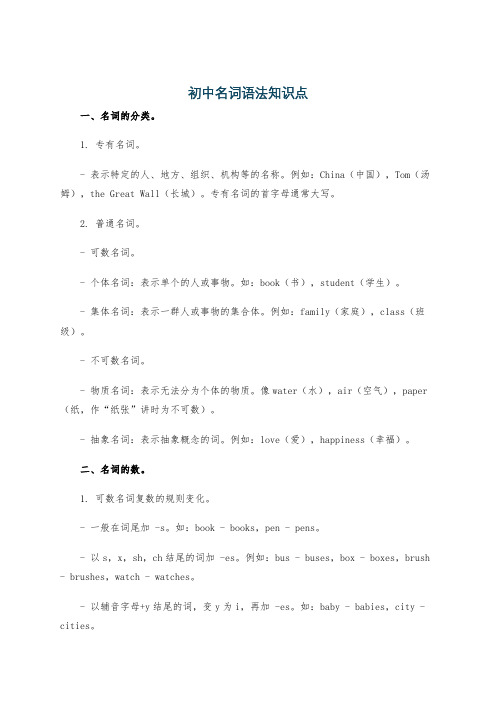
初中名词语法知识点一、名词的分类。
1. 专有名词。
- 表示特定的人、地方、组织、机构等的名称。
例如:China(中国),Tom(汤姆),the Great Wall(长城)。
专有名词的首字母通常大写。
2. 普通名词。
- 可数名词。
- 个体名词:表示单个的人或事物。
如:book(书),student(学生)。
- 集体名词:表示一群人或事物的集合体。
例如:family(家庭),class(班级)。
- 不可数名词。
- 物质名词:表示无法分为个体的物质。
像water(水),air(空气),paper (纸,作“纸张”讲时为不可数)。
- 抽象名词:表示抽象概念的词。
例如:love(爱),happiness(幸福)。
二、名词的数。
1. 可数名词复数的规则变化。
- 一般在词尾加 -s。
如:book - books,pen - pens。
- 以s,x,sh,ch结尾的词加 -es。
例如:bus - buses,box - boxes,brush - brushes,watch - watches。
- 以辅音字母+y结尾的词,变y为i,再加 -es。
如:baby - babies,city - cities。
- 以f或fe结尾的词,多数变f或fe为v,再加 -es。
例如:leaf - leaves,knife - knives。
但也有一些直接加 -s的,如:roof - roofs。
2. 可数名词复数的不规则变化。
- 改变元音字母。
如:man - men,woman - women,foot - feet,tooth - teeth。
- 单复数同形。
如:fish(表示鱼的种类时可加 -es),sheep,deer等。
- 表示“某国人”的复数形式:- 单复数同形:Chinese(中国人),Japanese(日本人)。
- 词尾加 -s:American - Americans,German - Germans。
- 把 -man变为 -men:Englishman - Englishmen,Frenchman - Frenchmen。
初中英语名词语法整理整理
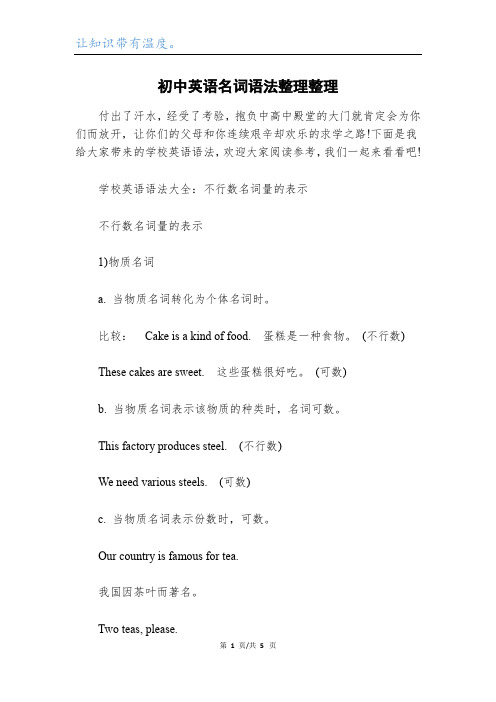
初中英语名词语法整理整理付出了汗水,经受了考验,抱负中高中殿堂的大门就肯定会为你们而放开,让你们的父母和你连续艰辛却欢乐的求学之路!下面是我给大家带来的学校英语语法,欢迎大家阅读参考,我们一起来看看吧!学校英语语法大全:不行数名词量的表示不行数名词量的表示1)物质名词a. 当物质名词转化为个体名词时。
比较:Cake is a kind of food.蛋糕是一种食物。
(不行数)These cakes are sweet.这些蛋糕很好吃。
(可数)b. 当物质名词表示该物质的种类时,名词可数。
This factory produces steel.(不行数)We need various steels.(可数)c. 当物质名词表示份数时,可数。
Our country is famous for tea.我国因茶叶而著名。
Two teas, please.请来两杯茶。
2) 抽象名词有时也可数。
four freedoms 四大自由the four modernizations四个现代化物质名词和抽象名词可以借助单位词表肯定的数量。
如:a glass of water 一杯水a piece of advice一条建议学校英语语法大全:名词复数不规章变化名词复数的不规章变化1)child---children foot---feet tooth---teethmouse---mice man---men woman---women留意:与man 和woman构成的合成词,其复数形式也是-men 和-women。
如:an Englishman,two Englishmen. 但German不是合成词,故复数形式为Germans;Bowman是姓,其复数是the Bowmans。
2)单复同形如:deer,sheep,fish,Chinese,Japaneseli,jin,yuan,two li,three mu,four jin但除人民币元、角、格外,美元、英镑、法郎等都有复数形式。
初中英语名词概念的语法
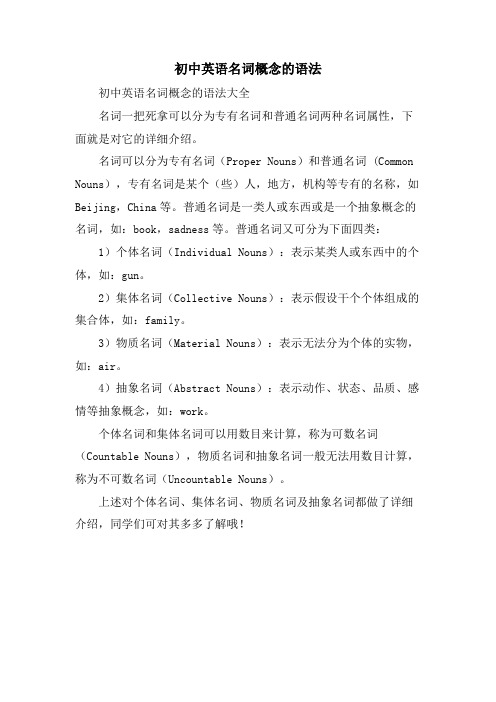
初中英语名词概念的语法
初中英语名词概念的语法大全
名词一把死拿可以分为专有名词和普通名词两种名词属性,下面就是对它的详细介绍。
名词可以分为专有名词(Proper Nouns)和普通名词 (Common Nouns),专有名词是某个(些)人,地方,机构等专有的名称,如Beijing,China等。
普通名词是一类人或东西或是一个抽象概念的名词,如:book,sadness等。
普通名词又可分为下面四类:1)个体名词(Individual Nouns):表示某类人或东西中的个体,如:gun。
2)集体名词(Collective Nouns):表示假设干个个体组成的集合体,如:family。
3)物质名词(Material Nouns):表示无法分为个体的实物,如:air。
4)抽象名词(Abstract Nouns):表示动作、状态、品质、感情等抽象概念,如:work。
个体名词和集体名词可以用数目来计算,称为可数名词(Countable Nouns),物质名词和抽象名词一般无法用数目计算,称为不可数名词(Uncountable Nouns)。
上述对个体名词、集体名词、物质名词及抽象名词都做了详细介绍,同学们可对其多多了解哦!。
初中英语语法整理:名词各项语法
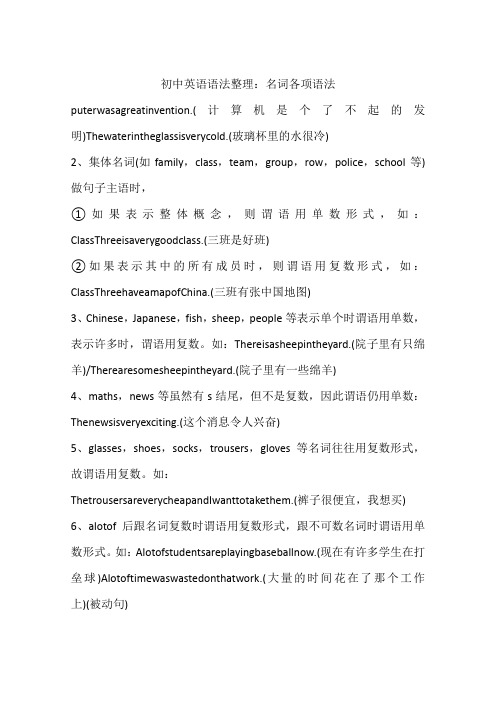
初中英语语法整理:名词各项语法puterwasagreatinvention.(计算机是个了不起的发明)Thewaterintheglassisverycold.(玻璃杯里的水很冷)2、集体名词(如family,class,team,group,row,police,school等)做句子主语时,①如果表示整体概念,则谓语用单数形式,如:ClassThreeisaverygoodclass.(三班是好班)②如果表示其中的所有成员时,则谓语用复数形式,如:ClassThreehaveamapofChina.(三班有张中国地图)3、Chinese,Japanese,fish,sheep,people等表示单个时谓语用单数,表示许多时,谓语用复数。
如:Thereisasheepintheyard.(院子里有只绵羊)/Therearesomesheepintheyard.(院子里有一些绵羊)4、maths,news等虽然有s结尾,但不是复数,因此谓语仍用单数:Thenewsisveryexciting.(这个消息令人兴奋)5、glasses,shoes,socks,trousers,gloves等名词往往用复数形式,故谓语用复数。
如:ThetrousersareverycheapandIwanttotakethem.(裤子很便宜,我想买)6、alotof后跟名词复数时谓语用复数形式,跟不可数名词时谓语用单数形式。
如:Alotofstudentsareplayingbaseballnow.(现在有许多学生在打垒球)Alotoftimewaswastedonthatwork.(大量的时间花在了那个工作上)(被动句)7、and连接两个名词做主语时,谓语原则上用复数,但是两个名词若构成一个整体事物时,谓语则用单数。
如:Theteacherandhissonarepickingapplesnow.(老师和他的儿子在摘苹果)/Fishandchipsisveryfamousfood.(鱼和薯条是一种出名的食品)8、therebe句型中be的单复数一般由靠近的名词决定。
- 1、下载文档前请自行甄别文档内容的完整性,平台不提供额外的编辑、内容补充、找答案等附加服务。
- 2、"仅部分预览"的文档,不可在线预览部分如存在完整性等问题,可反馈申请退款(可完整预览的文档不适用该条件!)。
- 3、如文档侵犯您的权益,请联系客服反馈,我们会尽快为您处理(人工客服工作时间:9:00-18:30)。
初中名词语法大全名词:1、英语名词可分专有名词和普通名词两大类:1、专有名词是个别的人、地、物、团体、机构等的专用名称。
专有名词中实词的第一个字母要大写。
如:Beijing, Tom, the People’s Republic of China(中华人民共和国)专有名词如果是含有普通名词的短语,则必须使用定冠词the。
如:the Great Wall(长城)姓氏名如果采用复数形式,则表示该姓氏一家人(复数含义),如:the Greens( 格林一家人)。
2、普通名词是许多人或事物的共有名称。
如:pupil, family, man, foot.普通名词又分为可数名词和不可数名词。
▲可数名词是可以用简单的数词进行计数的名词,如:box, child, orange;▲不可数名词是不可以用简单的数词进行计数的名词。
如:water, news, oil, population, information .2、英语可数名词的单复数:英语可数名词有单数和复数两种形式。
1、名词由单数变复数的基本方法如下:①在单数名词词尾加s。
如:map →maps,boy→boys,horse→horses, table→tables.②s,o,x ,sh,ch结尾的词加es.如:class→classes, box→boxes, hero→heroes, dish→dishes,bench→benches.[注]:少数以o结尾的词,变复数时只加s。
如:photo→photos, piano→pianos.③以辅音字母加y结尾的名词,变y为i,再加es。
如:family→families, city→cities, party →parties.④以f或fe结尾的名词,变f或fe为v,再加es。
如:shelf→shelves, wolf→wolves, life→lives, knife→knives.2、不规则变化:man→men, woman→women, sheep→sheep,tooth→teeth, fish→fish, child→children, ox→oxen, goose→geese不可数名词一般没有复数形式,说明其数量时,要用有关计量名词。
如:a bag of rice→two bags of rice, a piece of paper→three pieces of paper, a bottle of milk→five bottles ofmilk.3、名词所有格:1、名词所有格表示所属关系,相当于物主代词,在句中作定语、宾语或主语。
其构成法如下:(1)表示人或其它有生命的东西的名词常在词尾加’s。
如:Childern’s Day(儿童节), mysister’s book(我姐姐的书)(2)以s或es结尾的复数名词。
只在词尾加’。
如:Teachers’ Day(教师节)(3)有些表示时间、距离以及世界、国家、城镇等无生命的名词,也可在词尾加’s. 如:today’s newspaper(今天的报纸), ten minutes’ break(十分钟的课间休息),China’s population(中国的人口).(4)无论表示有生命还是无生命的东西的名词,一般均可用介词of短语来表示所有关系。
如:a fine daughter of the Party(党的好女儿).2、[注解]:①‘s还可以表示某人的家或者某个店铺,如:my aunt’s(我阿姨家), the doctor’s(诊所)②两人共有某物时,可以采用A and B’s的形式,如:Lucy and Lily’s bedroom(露西和丽丽合住的卧室)③“of+名词所有格/名词性物主代词”,称为双重所有格,如:a friend of my father’s(我父亲的一位朋友), a friend of mine(我的一位朋友)4、名词或代词作主语时和谓语之间的单复数的一致问题:1、谓语和谓语基本保持单复数的一致,即:主语是可数名词单数或不可数名词时,谓语动词用单数形式:如:The computer was a great invention.(计算机是个了不起的发明)The water in the glass is very cold.(玻璃杯里的水很冷)2、集体名词(如family, class, team, group, row, police, school等)做句子主语时,①如果表示整体概念,则谓语用单数形式,如:Class Three is a very good class.(三班是好班)②如果表示其中的所有成员时,则谓语用复数形式,如:Class Three have a map of China.(三班有张中国地图)3、Chinese, Japanese, fish, sheep, people等表示单个时谓语用单数,表示许多时,谓语用复数。
如:There is a sheep in the yard.(院子里有只绵羊)/ There are some sheep in the yard.(院子里有一些绵羊)4、maths, news等虽然有s结尾,但不是复数,因此谓语仍用单数:The news is very exciting.(这个消息令人兴奋)5、glasses, shoes, socks, trousers, gloves等名词往往用复数形式,故谓语用复数。
如:The trousers are very cheap and I want to take them.(裤子很便宜,我想买)6、a lot of后跟名词复数时谓语用复数形式,跟不可数名词时谓语用单数形式。
如:A lot ofstudents are playing baseball now.(现在有许多学生在打垒球) A lot of time was wasted on that work.(大量的时间花在了那个工作上)(被动句)7、and连接两个名词做主语时,谓语原则上用复数,但是两个名词若构成一个整体事物时,谓语则用单数。
如:The teacher and his son are picking apples now.(老师和他的儿子在摘苹果) / Fish and chips is very famous food. (鱼和薯条是一种出名的食品)8、there be句型中be的单复数一般由靠近的名词决定。
如:There is a table and four chairsin the room.(房间里有一张桌子和四张椅子)9、用both…and…连接两个事物做主语时,谓语一般用复数。
如:Both you and I are requiredto be here tomorrow.(你和我明天要求都来)10、主语中含有with的短语时,谓语单复数由with之前的人物决定。
如:A woman with a7-year-old child was standing at the side of the road. (一名妇女带着一个七岁的孩子(当时)就站在路边)11、either…or…或者neither…nor…连接两个人物做句子主语时,谓语采用就近原则。
如:Either you or he is right.(要么是你对,要么是他对。
/你和他有一个人是对的) / Neither you nor I am going there.(你和我都不打算去那里)12、表示一段时间或长度概念的复数名词做主语时,谓语一般用单数。
如:Two months is nota short time.(两个月不是个短时间)Two thousand kilometers is quite a long distance(距离).(两千千米是相当长的一段距离)13、主语中含有half of… / (three quarters)of… / all (of) the ….等词语时,谓语的单复数由名词确定,如:Over three quarters of the information on the Internet is in English.(因特网上四分之三以上的信息是用英语写的) / A third of the students were playing near the lake.(学生的三分之一(当时)正在湖边玩耍) / All of the water in these rivers has beenpolluted.(这些河流中的水已经被污染了)(被动句)但是,population一词又有特殊情况:What’s the population of China?(中国人口是多少?)(句子用单数)/ Three quarters of the population in this city are Arabs(阿拉伯人).(这个城市四分之三的人口是阿拉伯人)(句子用复数)5、部分名词用法辨析:1、sport、game、match、race的区别:sport通常指“户外运动”,以锻炼为主,概念较大;game意思是“运动、比赛”,不管户内户外还是脑力体力,指以胜负为主的运动;match意为“竞赛、比赛”,多指正式比赛;race主要表示“赛跑、赛马、赛车”。
如:People all around the world enjoy sports.(全世界的人都喜爱运动) / The 2008 Olympic Games will be held in Beijing.(2008奥运会将在北京举行)(被动句) / Our school football team won the league match(联赛).(我们学校足球队取得了联赛冠军) / They were strong and won the boat race.(汤他们很棒,赢得了划艇比赛)2、festival、holiday、vacation的区别:festival“节日”,指喜庆的日子或持续一段时间的文娱活动;holiday(假日、休息日),指法定假日或风俗习惯,复数可以表示一个较长的假期;vacation“假期”,指学习或工作中一段长时间的休息。
如:The Shanghai Television Festival will be held next month.(上海电视节将在下个月举行) / Sunday is a holiday and most people do not work.(星期天是个假日,多数人不工作)/ What are you going to do during the summer vacation/holidays?(在暑期你打算做什么事情?)3、journey、tour、trip、travel的区别:journey指在陆地上(或海上或空中)进行的长途旅行,不知终点,含有辛苦的意思;tour指途中作短期逗留的巡回旅行,强调游览多处,常用来指观光等;trip通常指往返定时的短途旅行,如出差度假等;travel多指长期或长途的观光旅行,尤其指到国外,没有明确目的地,也作不可数名词,指旅行这一行为。
